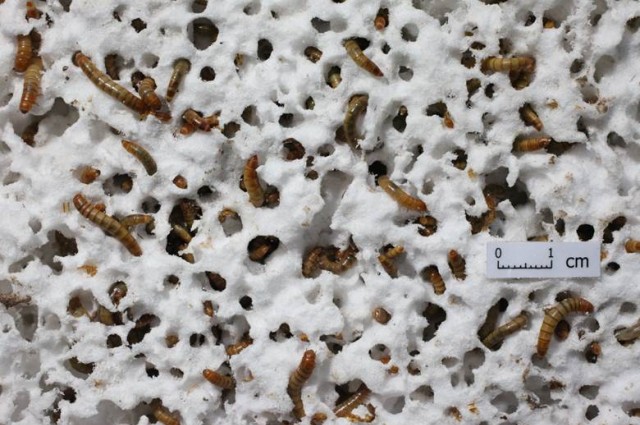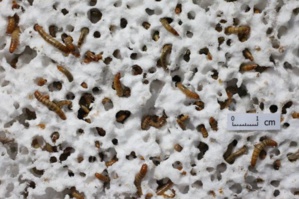Recently, the plastic pollutants have been a cause of worry as it is difficult to dispose of them. However, finally, there seems to be light at the end of the tunnel, whereby the mealworms can prove to be the rescuer. According to a recent study that was published in “Environmental Science and Technology”, the mealworms can become the “natural trash-disposers” which can eat up the army of plastic pollutants.
The study comes up with “in-depth evidence” which reveals that the mealworms are able to survive on Styrofoam diet, including various “other types of polystyrene plastic”. These kinds of plastic are found easily in the plastic mound in landfills, which were “previously considered non-biodegradable”. Professor, Craig Criddle stated:
“There's a possibility of really important research coming out of bizarre places. Sometimes, science surprises us. This is a shock.”
During the case study, the scientists tested on “100 mealworms” that were left on “34-39 milligrams of Styrofoam” a day. Their gut microbes’ turned fifty percent of the “plastic into carbon dioxide” while the rest turned into their excreta “in the form of biodegradable droppings”. In fact, the worms remained as healthy on a plastic diet as they were on “a normal diet”. Moreover, there are possibilities that the excreta of mealworms can be used “as soil for crops”, though further research is required before drawing any conclusion.
However, the most shocking “breakthrough” part of this study relates to the discovery of the fact that the guts of the mealworms are capable of digesting “non-biodegradable product” like “polystyrenes” which is “ubiquitous and problematic for our environment”. Furthermore, if the scientists identify the “exact microorganisms responsible for this incredible feat”, they can even “replicate” the process in an artificial set up. Stanford University’s “research engineer”, Wei-Min Wu said:
"Our findings have opened a new door to solve the global plastic pollution problem.”
According to statistical figures of the EPA data:
“In the U.S. alone, more than 33 million tons of plastic get dumped into landfills each year, and less than 10% of that waste is recycled. The plastic can then pollute soils and waters, threaten marine ecosystems, and polystyrene foams like Styrofoam can take more than a million years to decompose”.
Subsequently, the researchers will study the effect of these organisms in the higher rung of chain, to scrutinise “the effect”. Likewise, they will take into accounts the potential predators of mealworms and the next rung of predators who feast on the latter in turn. Moreover, there are attempts to find “a marine equivalent to mealworms that could be the defenders the Earth’s oceans need by digesting plastic that typically finds its way into the guts of seabirds, turtles and fish” and at times proves fatal. The mealworms are a living proof of the saying that “one man’s trash is another’s delectable delight”.
References:
http://www.iflscience.com
The study comes up with “in-depth evidence” which reveals that the mealworms are able to survive on Styrofoam diet, including various “other types of polystyrene plastic”. These kinds of plastic are found easily in the plastic mound in landfills, which were “previously considered non-biodegradable”. Professor, Craig Criddle stated:
“There's a possibility of really important research coming out of bizarre places. Sometimes, science surprises us. This is a shock.”
During the case study, the scientists tested on “100 mealworms” that were left on “34-39 milligrams of Styrofoam” a day. Their gut microbes’ turned fifty percent of the “plastic into carbon dioxide” while the rest turned into their excreta “in the form of biodegradable droppings”. In fact, the worms remained as healthy on a plastic diet as they were on “a normal diet”. Moreover, there are possibilities that the excreta of mealworms can be used “as soil for crops”, though further research is required before drawing any conclusion.
However, the most shocking “breakthrough” part of this study relates to the discovery of the fact that the guts of the mealworms are capable of digesting “non-biodegradable product” like “polystyrenes” which is “ubiquitous and problematic for our environment”. Furthermore, if the scientists identify the “exact microorganisms responsible for this incredible feat”, they can even “replicate” the process in an artificial set up. Stanford University’s “research engineer”, Wei-Min Wu said:
"Our findings have opened a new door to solve the global plastic pollution problem.”
According to statistical figures of the EPA data:
“In the U.S. alone, more than 33 million tons of plastic get dumped into landfills each year, and less than 10% of that waste is recycled. The plastic can then pollute soils and waters, threaten marine ecosystems, and polystyrene foams like Styrofoam can take more than a million years to decompose”.
Subsequently, the researchers will study the effect of these organisms in the higher rung of chain, to scrutinise “the effect”. Likewise, they will take into accounts the potential predators of mealworms and the next rung of predators who feast on the latter in turn. Moreover, there are attempts to find “a marine equivalent to mealworms that could be the defenders the Earth’s oceans need by digesting plastic that typically finds its way into the guts of seabirds, turtles and fish” and at times proves fatal. The mealworms are a living proof of the saying that “one man’s trash is another’s delectable delight”.
References:
http://www.iflscience.com






